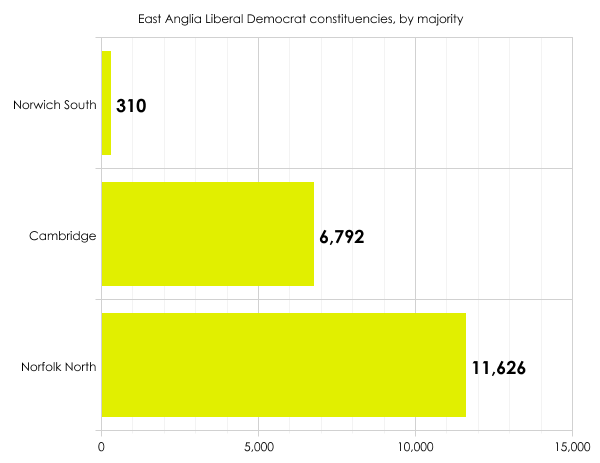Regions
East Anglia: Labour’s desert
East Anglia is a stark illustration of the extent to which Labour has been in retreat from shire and rural seats since Tony Blair’s victory in 1997.
The party has been wiped out across the region. Almost all of the 23 seats in Norfolk, Suffolk and Cambridgeshire are now Tory heartlands. Only a dab of yellow interrupts the blue:
East Anglia has become virtually a one-party region.
But this means that come the election there will be only one party hunting for gains.
Things have become so polarised here that not one Tory or Liberal Democrat target lies within East Anglia. Of the region’s small number of marginals, all are on Labour’s hit list.
Here are East Anglia’s key electoral statistics:
- Number of marginals: 6, or 26.1% of total
- Number of ultra-marginals: 2, or 8.7%
- Conservative targets: 0
- Labour targets: 6
- Lib Dem targets: 0
The degree to which we’ll see any marked change in the political composition of East Anglia at the election depends almost wholly on Labour’s effectiveness in winning its half-dozen targets.
They’ll probably succeed in at least three of the six, but doing a full sweep hinges on the size of the swing and the impact of local campaigns.
Five of the six targets are Tory marginals – the first five on this list:
Labour ought to win Ipswich and Norwich North: two seats in cities where the party already has a strong presence on the local council. Ipswich was most recently a Labour constituency from 1992-2010, and at an earlier time was once held for the party by Dingle Foot, brother of Michael. Labour’s candidate in 2015, David Ellesmere, is the current leader of the council.
The Tories won Norwich North from Labour in a by-election in 2009, but Chloe Smith’s majority was almost halved a year later in the general election. Jessica Asato, an adviser to Tessa Jowell, is Labour’s candidate in 2015.
Waveney should really fall to Labour as well. Labour’s Bob Blizzard is hoping to take back the seat he lost to Peter Aldous in 2010.
But here, as in Great Yarmouth and Peterborough, a strong showing by Ukip might disrupt the two-party swing and allow the incumbent to hold on. Ukip is certainly eyeing East Anglia, in particular its coastal constituencies, as fertile ground for votes, though I’m always wary of extrapolating success at local or European elections into victories on a nationwide level.
The last seat on Labour’s hit list of six is Norwich South: one of the trio of Lib Dem seats in East Anglia.
Norwich South is Charles Clarke’s former seat. If the swing next year from Lib Dem to Labour turns out to be comparable with that suggested by the latest opinion polls or recent local elections in other English cities, the current MP Simon Wright won’t stand a chance.
One way or another, Labour’s exile from East Anglia should come to an end in 2015. Whether the party can manage more than two or three drops of red in this sea of blue is less certain.



Discussion